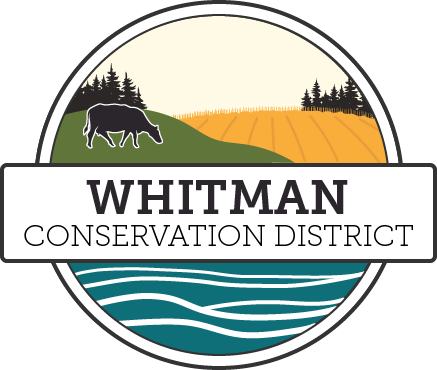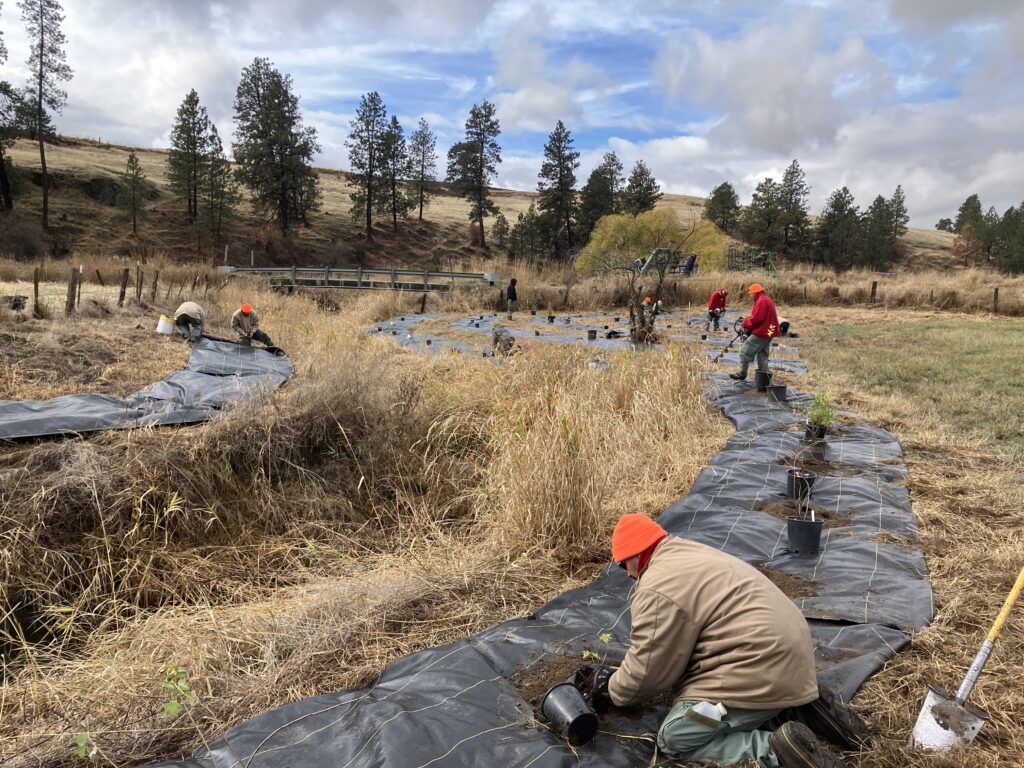Projects & Accomplishments
Highlights of Our Accomplishments From 2022...
Riparian Restoration
Rebuilding What Was Lost: Riparian Restoration in Whitman County
In one landowner’s lifetime, more than a dozen species have disappeared from their property—species that once thrived not only on local farms but throughout Whitman County. Salmon, macroinvertebrates, weasels, stoats—creatures that once sustained the natural balance—have vanished. The loss of these keystone species signals something deeper: a damaged ecosystem. As habitat has been cleared, waterways straightened, and natural buffers stripped away for farmland or lawns, the very foundation of the regional food web has crumbled.
In the Palouse, we’ve already lost an estimated six feet of topsoil since widespread plowing began. That rich soil, once the basis for food production and biodiversity, is now sediment in the river. And with it has gone the stability of both the land and the life it once supported.
At Whitman Conservation District, we are working to change that.
What Is Riparian Restoration?
Riparian restoration is the act of repairing and revitalizing streamside ecosystems—also known as riparian zones. These are the transitional areas between rivers or streams and the surrounding upland. Though often narrow, these zones are ecological powerhouses. They filter runoff, shade water to regulate temperature, stabilize banks, and provide habitat for countless species, from earthworms to moose.
Over the years, many of these stream corridors have been channelized—straightened and altered to direct water flow more efficiently for agriculture or development. While effective for human use in the short term, this process destroys the natural meanders and floodplains that allow riparian systems to absorb nutrients, reduce flooding, and sustain life.
That’s where our work begins.
Our Approach: Partnering with Landowners, Healing the Land
The Whitman Conservation District has implemented riparian restoration on about 25 project sites—a mix of long-standing and newly established locations. Our goal is not to interfere with farming practices, but to work in symbiosis with landowners, finding solutions that benefit both agriculture and the environment.
Our team works side-by-side with farmers and landowners to re-establish native vegetation, enhance streambank stability, and restore ecological function. We use proven techniques, such as:
Planting native trees and shrubs – These species are adapted to the climate and have deep root systems that stabilize soil, prevent erosion, and support local wildlife.
Installing PALS (Post-Assisted Log Structures) and BDAs (Beaver Dam Analogs) – These wood-based structures mimic natural features, redirecting water to slow its flow, trap sediment, create pools, and improve habitat for fish and other aquatic organisms.
Our projects focus on native species, which are more resilient and more effective at restoring function to damaged ecosystems.
Projects can be done either by cost share, or by district implementation.
All we ask is for access to the land. From there, we handle everything—planting, building, maintaining, and monitoring. For many farmers, this is a welcome relief. As one landowner put it:
“It’s not going to cost me anything. You just give them the land and they will build and plant bushes and trees and shrubs—things I don’t have time to do. I can’t just take on another job and build three miles of fence.”
The Results: Wildlife, Water, and the Return of Balance
The benefits are already visible. Restored riparian zones are now home to songbirds, pheasants, moose, and small mammals. Water flows more slowly through these shaded corridors, reducing erosion and filtering sediment. As vegetation grows, canopies begin to form, cooling the streams and creating conditions where aquatic life—like salmon—can return and thrive.
Landowners who were once skeptical—worried about bureaucracy or restrictions—now see the value. One shared:
“I was kind of skeptical about working with the Conservation District, taking government money… but they’ve been very easy to work with. And we’ve really had some good improvements to the land.”
Our projects aren’t about control. They’re about education, collaboration, and long-term stewardship. Conservation districts play a unique role in this—they help farmers see that even small changes today can lead to lasting benefits for their land, their children, and their children’s children.
A Vision for the Palouse
The Palouse is a land of beauty and abundance, but today, less than 2% of its native habitat remains. That’s not enough for biodiversity to flourish. But imagine if we restored even just 4%—what a difference that could make. We believe in that vision.
This isn’t about going backward. It’s about moving forward with balance—combining agriculture and conservation to ensure both can thrive.
We believe that restoring riparian zones is one of the most powerful ways to do that. And we believe the best way to restore them is together.

